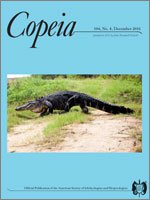The transition from aquatic to terrestrial phase in amphibians, called metamorphosis, is accompanied by ecological, morphological, physiological, and biochemical changes. These enable the digestive system of the animal to take up nutrients when the feeding habit changes from omnivorous/herbivorous in tadpoles to carnivorous in adults. To better understand this process, this study investigated the activity of four hydrolases in the digestive system of bullfrog (Lithobates catesbeianus) at all stages of larval development in which the animals feed from exogenous sources. Digestive enzyme activity increased from the beginning of the feeding phase until pre-metamorphosis, which is related to the maturation of the digestive system. The increase was more significant in the period of pro-metamorphosis, coinciding with the accumulation of energy reserves necessary for metamorphosis and the increased growth of the animal. During the climax of metamorphosis, the activities of digestive enzymes decreased, because the animal does not eat during this period. At the end of metamorphosis, in stage 45, the activity of proteolytic enzymes, acid proteases and trypsin, increased 35% and 400%, respectively, when compared to stage 44. Conversely, maltase activity remained constant whilst amylase activity decreased by 70%, which is consistent with the carnivorous feeding habit of the adult. These results enhance understanding of the development of digestive enzymes in the larval phase and in the change from omnivorous/herbivorous to carnivorous feeding habits. In addition, these findings provide insights for the formulation of appropriate diets for each developmental phase of tadpoles.
How to translate text using browser tools
14 November 2016
Ontogeny of the Digestive Enzymes of Tadpoles of Lithobates catesbeianus
Luiz Flávio José dos Santos,
Veronica Regina Lobato de Oliveira-Bahia,
Laura Satiko Okada Nakaghi,
Marta Verardino De Stefani,
Adriano Marques Gonçalves,
João Martins Pizauro Junior
ACCESS THE FULL ARTICLE





